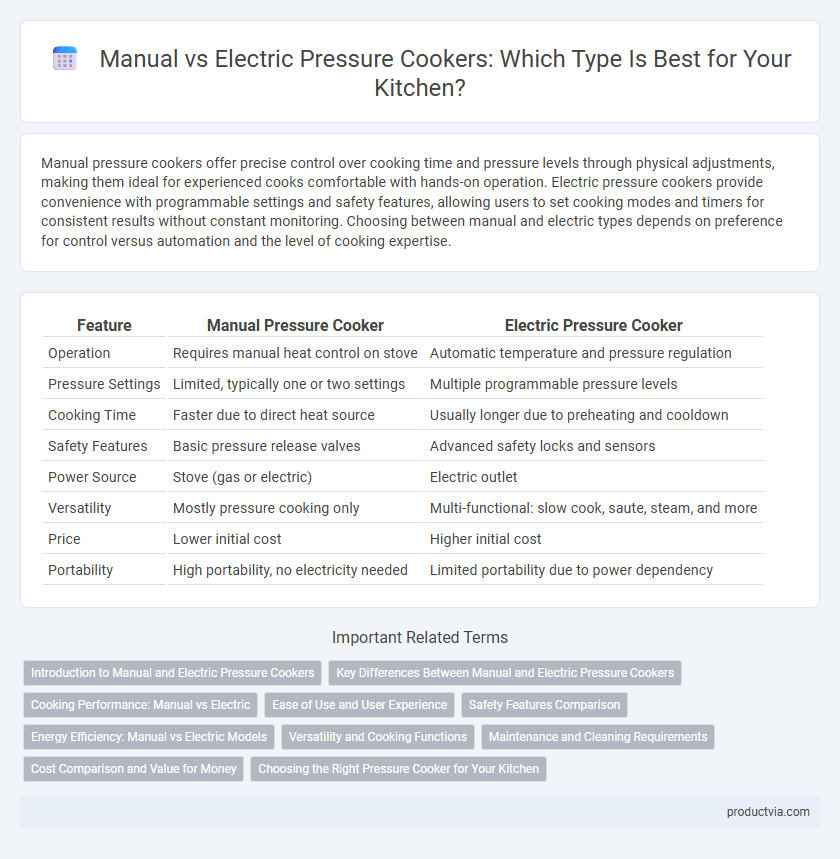Manual pressure cookers offer precise control over cooking time and pressure levels through physical adjustments, making them ideal for experienced cooks comfortable with hands-on operation. Electric pressure cookers provide convenience with programmable settings and safety features, allowing users to set cooking modes and timers for consistent results without constant monitoring. Choosing between manual and electric types depends on preference for control versus automation and the level of cooking expertise.
Table of Comparison
| Feature | Manual Pressure Cooker | Electric Pressure Cooker |
|---|---|---|
| Operation | Requires manual heat control on stove | Automatic temperature and pressure regulation |
| Pressure Settings | Limited, typically one or two settings | Multiple programmable pressure levels |
| Cooking Time | Faster due to direct heat source | Usually longer due to preheating and cooldown |
| Safety Features | Basic pressure release valves | Advanced safety locks and sensors |
| Power Source | Stove (gas or electric) | Electric outlet |
| Versatility | Mostly pressure cooking only | Multi-functional: slow cook, saute, steam, and more |
| Price | Lower initial cost | Higher initial cost |
| Portability | High portability, no electricity needed | Limited portability due to power dependency |
Introduction to Manual and Electric Pressure Cookers
Manual pressure cookers feature a stovetop design, relying on direct heat control and a simple pressure regulator for cooking, making them durable and straightforward. Electric pressure cookers combine advanced technology with programmable settings, offering automatic pressure regulation, timers, and multiple cooking modes for convenience. Both types deliver fast cooking times and retain nutrients, but manual models demand more attention, whereas electric versions provide hands-free operation.
Key Differences Between Manual and Electric Pressure Cookers
Manual pressure cookers rely on stovetop heat sources and require constant monitoring to regulate pressure, while electric pressure cookers feature built-in sensors and programmable settings for automated pressure control. Manual models typically offer faster heat-up times and higher maximum pressures, ideal for experienced cooks seeking precise control. Electric pressure cookers provide convenience with preset cooking programs, safety features, and multifunctionality, making them suitable for busy households prioritizing ease of use.
Cooking Performance: Manual vs Electric
Manual pressure cookers provide superior cooking performance with precise control over pressure levels and cooking time, ideal for experienced users seeking customizable results. Electric pressure cookers offer convenience and consistent pressure regulation through programmable settings, ensuring uniform cooking and energy efficiency. Both types achieve tender, flavorful dishes, but manual models excel in versatility while electric versions prioritize ease of use and automation.
Ease of Use and User Experience
Electric pressure cookers offer greater ease of use through programmable settings, digital controls, and built-in safety features, enhancing user experience by simplifying cooking processes. Manual pressure cookers require more hands-on monitoring and experience to manage pressure and timing accurately, which can be challenging for beginners but allows for more control in cooking. User preference often depends on balancing convenience with traditional cooking techniques and the desired level of control.
Safety Features Comparison
Manual pressure cookers rely on sturdy metal construction and basic pressure release valves to ensure safety, while electric pressure cookers incorporate multiple sensors and automated pressure control mechanisms for precise safety management. Electric models often include features such as lid lock systems that prevent opening under pressure, automatic temperature regulation, and overpressure protection, significantly reducing the risk of accidents. Manual cookers require careful user monitoring and knowledge of pressure levels, whereas electric options provide enhanced built-in safety protocols suitable for users seeking convenience and peace of mind.
Energy Efficiency: Manual vs Electric Models
Manual pressure cookers typically offer superior energy efficiency by retaining heat within a sealed chamber and requiring a heat source only during cooking, minimizing power consumption. Electric pressure cookers consume electricity continuously to maintain pressure and control cooking cycles, which can result in higher energy usage. Users seeking energy savings often prefer manual models due to their direct stovetop heat application and shorter cooking times.
Versatility and Cooking Functions
Manual pressure cookers offer exceptional versatility by allowing precise control over pressure levels and cooking times, making them ideal for a wide range of recipes. Electric pressure cookers come with multiple pre-programmed cooking functions such as slow cooking, sauteing, and steaming, providing convenience and consistent results with minimal monitoring. While manual cookers excel in simplicity and durability, electric models enhance functionality by combining pressure cooking with other cooking modes in one appliance.
Maintenance and Cleaning Requirements
Manual pressure cookers typically require more hands-on maintenance, including regular gasket replacement and careful cleaning of the pressure valve to ensure safe operation. Electric pressure cookers feature removable, dishwasher-safe components that simplify cleaning, while their electronic controls may need occasional software updates or professional servicing. Both types benefit from routine inspection and thorough drying to prevent rust and prolong their lifespan.
Cost Comparison and Value for Money
Manual pressure cookers typically cost significantly less, ranging from $30 to $80, making them a budget-friendly option for basic cooking needs. Electric pressure cookers, priced between $80 and $250, offer multifunctional features such as programmable timers and preset cooking modes, providing enhanced convenience and versatility. When evaluating value for money, manual models excel in durability and simplicity, while electric versions justify their higher cost through time-saving technology and expanded cooking capabilities.
Choosing the Right Pressure Cooker for Your Kitchen
Manual pressure cookers offer precise control over cooking pressure and time, ideal for users who prefer hands-on cooking and faster heat adjustments. Electric pressure cookers provide convenience with programmable settings and built-in safety features, making them suitable for busy households and multitasking cooks. Selecting the right pressure cooker depends on your cooking style, kitchen space, and desired level of automation.
Manual vs Electric for pressure cooker type Infographic

 productvia.com
productvia.com